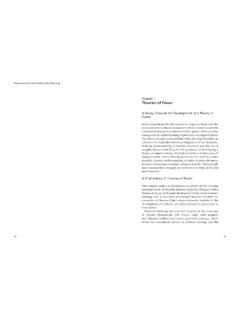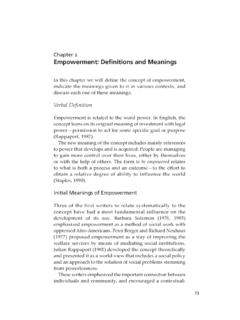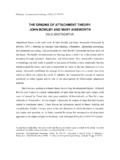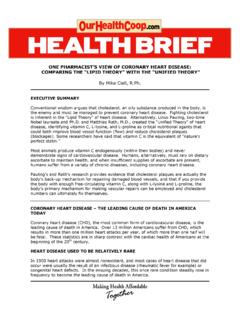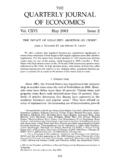Transcription of Chapter 3 Developing a Theory of Empowerment
1 137 Chapter 3 Developing a Theory of EmpowermentIn Search of a Meta-theoryEmpowerment Theory wants to make a place for itself among those new social theories that are attempting to connect the personal and the social, the individual and society, the micro and the macro. Connecting the individual and the collective in a way which is not organic-biological or systemic-mechanical is not unique to the present study: this is the great challenge of sociology in recent years (Ritzer, 1988). In our case, the search is for a connection between the micro level and the macro level. For the individual the micro level the Empowerment process is a process of increasing control and transition from a state of powerlessness. Community Empowerment the macro level is a collective social process of creating a community, achieving better control over the environment, and decision making in which groups, organizations or communities participate. Beside these two we have to develop the theoretical meaning of empowering professional practice, through which an abstract Theory is translated into a practical tool of Empowerment Theory requires a convincing integration of the micro and macro levels in order to make clear the interrelations among individual, community, and professional Empowerment .
2 In the search for this integration, I will present three theories which have taken on the challenge of connecting the individual and his behavior with the society and its processes. Drawing on these, I will go on to propose a Theory of Empowerment and Community PlanningIntegration of Micro and Macro Levels in Feminist ThoughtThe declaration that the personal is political is the feminist rationale for removing the separating fence between the micro as a personal domain and the macro as a public domain. The split between the personal and the public domains is essentially a social means of isolating women and separating them from communities which could validate their views about life and society (Ackelsberg, 1988). The recognition of the existence of mutual influence between private activity and social structures demands a connection between the personal world and what happens in political and public life. The change in the values and beliefs of the individual woman, in the goals that she sets herself, in the life-style she chooses and in the understanding of her existential problems is a political declaration that is aimed at a change of the social structures that influence her life (Van Den Bergh & Cooper, 1986).
3 The concept social individuality (Griscom, 1992) makes the feminist dialectics explicit. The woman is an individual within the social reality in which she grows up and develops with the contradictions between her and society. According to this holistic view, the separation between self, others, and community, is artificial, because these three create one another within a single complex whole. The powerlessness of one woman, which changes by means of her activism in collaboration with others in her situation, is a process that empowers the entire community of thought attacks the illusion of objectivity. Since knowledge about the social world is always created from a social position, no comprehensive and uniform social outlook really exists. People positioned in different places in the social structure know different things about the world. Hence, when a social view is presented as objective and exclusively valid, it is only an expression of the excessive rights that a certain group has appropriated for itself in the social order (Lengermann & Neibrugge-Brantley, 1988).
4 139 Chapter 3: Developing a Theory of EmpowermentSeveral important ideas follows from this thinking:The work of production and maintenance in society is done by subordinates whose work is in most cases invisible, and because of a dominant social ideology is not appreciated either by the society or by those who actually do the work. As a consequence, the understanding of the real components of production in society is distorted (Markusen, 1980). A senior manager in a large company can devote all his time to his job thanks to his wife, who takes care of him, their children, his elderly parents, and their home. For the firm, and for the society as well, the invisible work of this woman is of no economic value. It is women, irrespective of their status, who do most of this invisible work, not only in the domestic domain, cleaning, cooking, maintenance, and providing emotional and sexual services. In paid work too they do most of the activities of coordinating, such as waiting, arranging meetings, mediating, being interrupted, which are also considered unimportant.
5 Another part of women s work, which is more obvious in its contribution to social production motherhood receives social glorification and idealization, which convert it into an unrealistic a consequence of this women walk on a line of fault that separates the dominant ideology about their role in social life from their actual experience as they understand it. The incompatibility between the private reality and the social generalizations creates a constant dissonance with reality, and women navigate their lives according to this sense of separation between them and the society. On this line of fault, women navigate in different ways: some by repression, some by acquiescence, some by rebellion, and some by an attempt to organize social change (Lengermann & Neibrugge-Brantley, 1988).All that has been said here about women may be applied analogously, although not in a totally identical form, to all powerless people who are subordinate to others.
6 These people cannot express themselves as individuals, and silently accept other people s interpretations of their actions and failures. 140 Empowerment and Community PlanningThis is the source of the culture of silence that characterizes life in conditions of inequality (Gaventa, 1980).The conclusion of feminist Theory is to question accepted categorizations that were developed by disciplines that are basically dominated by men (such as sociology, for example). The aim is to create alternative concepts which can help to explain the world as it appears to its invisible and disadvantaged subordinate subjects (Lengermann & Neibrugge-Brantley, 1988).Theorists must engage in dialectical analysis of the knowledge process, and be conscious of the constant tension that exists between the subject and the object each affecting and changing the other. The knower (the subject, the theorist) has to admit his interaction with the knowledge (the object), for knowledge about the social world is always created from a social connection between the personal and the political, which characterizes the feminist approach, has been warmly adopted into the Theory of Empowerment , as has the premise that feminism is valid not only for women, but also for everyone whose world is characterized by oppression and marginality.
7 Empowerment wants to turn public attention to the distress of groups that are in need of social Transactional Approach in Environmental PsychologyThe transactional Theory in environmental psychology (Altmann & Rogoff, 1987) proposes a bridge between the micro level the person and the macro level the environment. In the transactional approach, which is influenced by both phenomenology and ethnomethodology (Berger & Luckmann, 1967; Mehan & Wood, 1975), the unit of analysis is a holistic entity an event, generally in which people, psychological processes, and environments are involved. The transactional whole is not composed of separate parts (like the whole in systems Theory ), but is a compound of inseparable factors that 141 Chapter 3: Developing a Theory of Empowermentare dependent upon one another for their very meaning and definition. The whole person-environment is a happening that is changing all the time. Various aspects of the event accord mutual meaning to one another, for in a different setting, or with different actors, a particular person would have acted differently.
8 The observer (the researcher), too, is part of the event, since she defines the event and its boundaries, and her approach and behavior dictate part of the phenomenon. Understanding the observer during the event, her point of view, her role and her position, is part of the interpretation of the event. The transactional Theory is pragmatic, eclectic, and relativistic. Despite its ambition to be able to predict, it recognizes that the events are liable to be idiosyncratic and principles stem from this Theory :1. Change is a property of the whole entity of the event itself. Change is expected since processes are temporary by their very definition. An understanding of the change of how it comes about and of its form is required in order to understand the phenomenon, and not, as in other approaches, in order to understand the change and its reasons. The description and analysis of the event focus on the study of process and Since the basic research unit is an event involving psychological, temporal, environmental, and social aspects, any focus of the research on one of these aspects turns the others into a context.
9 For example, if the focus of the study is the psychological aspects of an event, then the physical environment is its The perceptions and perspectives of the participants in an event are important for an understanding of the event. The analysis is not done solely from the perspective of the researcher who, as already noted, is one aspect of the event. The transactional approach studies the ways different observers interpret the same Methodological eclecticism: Resaerch methods are produced out of the event, not imposed upon it. The 142 Empowerment and Community Planningtheory and the structure of assumptions are constants, while the strategies of study may vary. A study is designed according to the problem and the question being studied. Hence, even when it is not possible to do the research empirically, it is important to report and acknowledge this, so that even without empirical research it will be possible to understand the entire picture transactional Theory , Empowerment Theory has taken the place of the professional as an inseparable part of the social situation itself, the emphasis on the process, and the freedom to move between focus and context that this Theory permits the Theory : Giddens Duality of StructureGiddens structuration Theory (1982, 1984) which is also called the Theory of duality of structure, after its central principle is the most developed among those sociological theories that integrate micro and macro levels of analysis (Ritzer, 1988).
10 On this Theory , the social structure has neither primacy nor preference over the human agency, and vice versa. Social structure is the outcome of human action, and this action is made possible within the boundaries of the social structure in which it takes makes use of the term system to describe the overt pattern of social structures. The social outcomes both the intentional and the unexpected are an embodiment of the actions of human agencies. Social systems are reproduced social practices that are embedded in time and and resources are drawn upon in the production and reproduction of social action. At the same time they are the means of system reproduction (the duality of structure). Human agency is enabled by means of social rules and resources. The rules guide and inform the action, and the resources provide it with energy: purpose, power, and 3: Developing a Theory of EmpowermentThe three concepts that are central to an understanding of human agency and the social structure are communication, power, and sanction.
